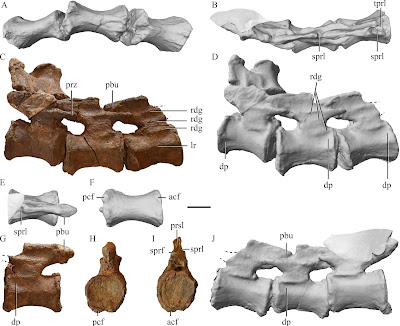Garumbatitan
- Total Dino
- Jun 22, 2024
- 3 min read
Updated: Jul 15
MEANING: Garumba giant
PERIOD: Early Cretaceous
CONTINENT: Europe
Garumbatitan is a sauropod dinosaur from the Early Cretaceous of what is now Spain. It is classified as a basal somphospondylan - a titanosauriform, but not a true titanosaur. Of the three individuals discovered, the largest had vertebrae more than a meter wide, and a femur that could reach two meters in length.

Abstract from paper: A new somphospondylan titanosauriform from the Lower Cretaceous of Spain is described from the remains found at the Sant Antoni de la Vespa site (upper Barremian Arcillas de Morella Formation) located in Morella. Garumbatitan morellensis gen. et sp. nov. is diagnosed by 11 autapomorphies and eight local autapomorphies; and our phylogenetic analyses suggest that Garumbatitan morellensis might correspond to an early-branching somphospondylan. The presence of several somphospondylan traits in Garumbatitan morellensis supports the somphospondylan hypothesis. The phylogenetic distribution of some titanosauriform and somphospondylan novelties in the femur (markedly developed lateral bulge, high shaft eccentricity, linea intermuscularis cranialis, and trochanteric shelf) is discussed. The tarsus and pes of Garumbatitan morellensis are distinctive, being characterized by the loss of the calcaneum, relative slenderness of the metatarsals II, III, and IV when compared to the retracted metatarsals I and V, three pedal phalanges in digit IV, and reduced ungual III. The sauropod fauna of the Iberian Peninsula during the Hauterivian–Aptian shows a complex phylogenetic mosaic, including forms with Laurasian affinities, mainly titanosauriforms (Soriatitan, Garumbatitan, and possibly Tastavinsaurus and Europatitan), and Gondwanan affinities, the rebbachisaurid Demandasaurus. Faunal exchange during the Early Cretaceous between the Europe, North America, East Asia, and Africa is plausible.
Garumbatitan is from the Early Cretaceous. The Cretaceous is the third and final geological period of the Mesozoic Era, with the Early Cretaceous making up roughly the first half, lasting from about 143 to 100 million years ago. The poles were ice-free, due to the relatively warm climate, and forests extended into high latitudes. The continued breakup of the continents created new coastlines and isolated landmasses, influencing the evolution of distinct dinosaur faunas.
It was a time of transition, as many groups of animals and plants began to take on more modern forms while others declined or disappeared. Pterosaurs continued to thrive, though early birds were becoming more diverse and widespread. Mammals remained small but adapted to a variety of ecological niches. In the oceans, ichthyosaurs and plesiosaurs were common, and early mosasaurs began to appear.
Dinosaurs remained the dominant land animals, with groups like iguanodontians, spinosaurids, and carcharodontosaurids rising to prominence. While sauropods declined in some regions, they remained abundant in the Southern Hemisphere. The first true ceratopsians appeared, and ankylosaurs replaced stegosaurs in their niche. Dromaeosaurs and other small theropods diversified. During this time, the first flowering plants evolved, gradually changing global ecosystems by providing new food sources for herbivores.

Garumbatitan is a macronarian. Macronaria is a major clade of sauropod dinosaurs, characterized by their large nasal openings. This group includes some of the most famous and massive dinosaurs in history, such as Brachiosaurus and Camarasaurus, as well as their many relatives that flourished from the Jurassic through the Cretaceous Periods. Macronarians were herbivorous, long-necked dinosaurs with relatively upright neck posture, allowing them to feed from tall trees and vegetation other sauropods may not have reached. Their skulls tend to be short and boxy compared to the more elongated skulls of diplodocoids, and their teeth were often spoon-shaped, well-suited for stripping leaves rather than raking or cropping.
Early macronarians appeared in the Late Jurassic and were among the most common sauropods in their ecosystems. Later forms diversified dramatically, including the enormous titanosaurs that would dominate sauropod diversity in the Cretaceous. While the more basal members retained relatively conservative body plans, some later macronarians reached extreme sizes and adapted to a wide range of habitats. The group’s evolutionary success is reflected in its global distribution, with fossils found on every continent, including Antarctica. As some of the tallest terrestrial animals known from the fossil record, macronarians represent an important stage in the evolution of sauropod body plans and feeding strategies.









